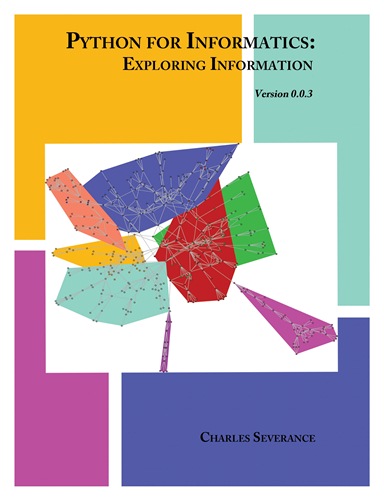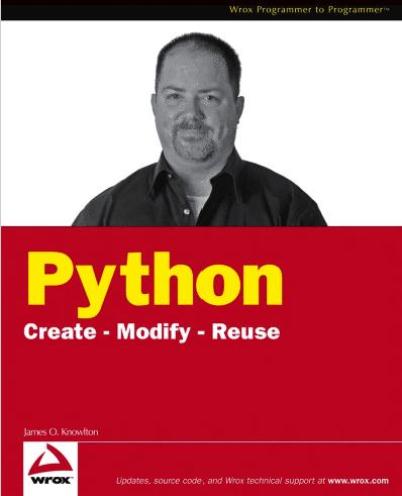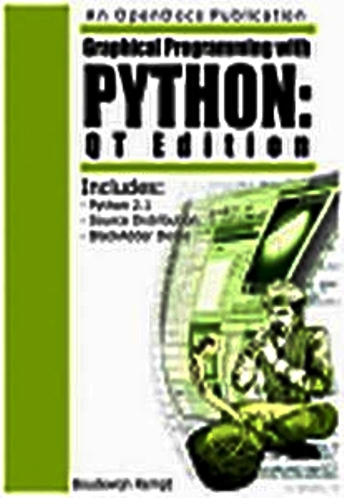|
|
Каталог файлов
В категории материалов: 64
Показано материалов: 1-10 |
Страницы: 1 2 3 ... 6 7 » |
Сортировать по:
Дате ·
Названию ·
Рейтингу ·
Комментариям ·
Загрузкам ·
Просмотрам

Год выпуска: 2009
Язык: Английский
Издательство: Charles Severance Формат: PDF
Количество страниц: 232
Описание: It is quite natural for academics who are continuously told to "publish or perish” to want to always create something from scratch that is their own fresh creation. This book is an experiment in not starting from scratch, but instead "re-mixing” the book titled Think Python: How to Think Like a Computer Scientist written by Allen B. Downey, Jeff Elkner and others. In December of 2009, I was preparing to teach SI502 - Networked Programming at the University of Michigan for the fifth semester in a row and decided it was time to write a Python textbook that focused on exploring data instead of understanding algorithms and abstractions. My goal in SI502 is to teach people life-long data handling skills using Python. Few of my students were planning to be be professional computer programmers. Instead, they planned be librarians, managers, lawyers, biologists, economists, etc. who happened to want to skillfully use technology in their chosen field. I never seemed to find the perfect data-oriented Python book for my course so I set out to write just such a book. Luckily at a faculty meeting three weeks before I was about to start my new book from scratch over the holiday break, Dr. Atul Prakash showed me the Think Python book which he had used to teach his Python course that semester. It is a well-written Computer Science text with a focus on short, direct explanations and ease of learning. The overall book structure has been changed to get to doing data analysis problems as quickly as possible and have a series of running examples and exercises about data analysis from the very beginning. The first 10 chapters are similar to the Think Python book but there have been some changes. Nearly all number-oriented exercises have been replaced with data-oriented exerises. Topics are presented in the order to needed to build increasingly sophisticated data analysis solutions. Some topics like try and except are pulled forward and presented as part of the chapter on conditionals while other concepts like functions are left until they are needed to handle program complexity rather introduced as an early lesson in abstraction. The word "recursion” does not appear in the book at all.
|

Год выпуска: 2009
Автор:Tim Hall and J-P Stacey Язык: Английский
Издательство: Apress
ISBN: 978-1-4302-1633-9 Формат: PDF
Количество страниц: 314
Описание: There are many more people who want to study programming other than aspiring computer scientists with a passing grade in advanced calculus. This guide appeals to your intelligence and ability to solve practical problems, while gently teaching the most recent revision of the programming language Python. You can learn solid software design skills and accomplish practical programming tasks, like extending applications and automating everyday processes, even if you have no programming experience at all. Authors Tim Hall and J–P Stacey use everyday language to decode programming jargon and teach Python 3 to the absolute beginner.
What you’ll learn Cultivate a problem–solving approach and acquire software design skills. Learn how to create your own software from simple "Hello World” type programs to stand–alone windowed applications. Document while programming, program while documenting. Decode programmers’ jargon. Master the Python 3 programming language.
Who is this book for Non–programmers who want to learn Python programming without taking a detour via a computer science department. |

Год выпуска: 2008
Автор: Jim Knowlton Язык: Английский
Издательство:Wiley
ISBN: 978-0-470-25932-0 Формат: PDF
Количество страниц: 291
Описание:Python: Create-Modify-Reuse is designed for all levels of Python developers interested in a practical, hands-on way of learning Python development. This book is designed to show you how to use Python (in combination with the raw processing power of your computer) to accomplish real-world tasks in a more efficient way. Don't look for an exhaustive description of the Python language––you won't find it. The book's main purpose is not to thoroughly cover the Python language, but rather to show how you can use Python to create robust, real-world applications. In this respect, the goal is similar to foreign-language books that identify themselves as "conversational,” focusing on the vocabulary and concepts that people will need the most. Likewise, I focus specifically on the Python knowledge needed to accomplish practical, specific tasks. Along the way, you will learn to create useful, efficient scripts that are easy to maintain and enhance. This book is for developers with some experience with Python who want to explore how to develop full-blown applications. It is also for developers with experience in other languages who want to learn Python by building robust applications. It is well-suited for developers who like to "learn by doing,” rather than exploring a language feature by feature. To get the most out of the book, you should understand basic programming principles. Because this book is project-based, you can approach it in numerous ways. You can, of course, read it from cover to cover. Chapters 2 through 8 each cover a different project, so the chapters are independent of each other. However, because each chapter project is covered individually, there may be some overlap of information. I also sometimes refer to explanations of particular topics covered in previous chapters. This will help to reinforce important concepts. The end of the book contains two appendixes. The first one is a listing of Python resources you can check out for more information. The second one will help you with installing additional components used in some of the examples. This book starts with a basic overview of the Python language, designed for those familiar with other languages but new to Python. It is followed by several chapters, each of which describes a complete project that can be used as-is or modified and extended to suit your particular purposes. You'll find applications that access databases, take advantage of web technologies, and facilitate network communications, to name a few. In addition, and more important than the technologies you will be introduced to, you will learn how to use Python to solve real challenges. Following these chapters are two chapters that cover accessing operating system resources and debugging and testing, respectively.
|

Год выпуска: 2009
Автор:Jennifer Campbell, Paul Gries, Jason Montojo, Greg WilsonЯзык: Английский Издательство: Pragmatic Bookshelf ISBN: 1-934356-27-1 Формат: PDF
Количество страниц: 369
Описание: Science is about learning by performing experiments. This book encourages computer science students to experiment with short, interactive Python scripts and in the process learn fundamental concepts such as data structures, sorting and searching algorithms, object-oriented programming, accessing databases, graphical user interfaces, and good program design. Clearly written text along with numerous compelling examples, diagrams, and images make this an excellent book for the beginning programmer.
|

Год выпуска: 2011
Автор: Jules J. Berman Язык: Английский
Издательство: CRC Press
ISBN: 978-1-4398-4182-2
Формат: PDF
Количество страниц: 401
Описание:There are many talented and energetic healthcare workers who have basic programming skills, but who have not had an opportunity to use their skills to help their patients or advance medical science. Too often, healthcare workers are led to believe that medical informatics is a complex and specialized ⓝeld that can only be mastered by teams of professional programmers. Иis is just not the case. A few dozen simple algorithms account for the bulk of activities in the ⓝeld of medical informatics. Moreover, in the past decade, gigabytes of medical data, comprising many millions of deidentiⓝed clinical records, have been released into the public domain, and are freely accessible via the Internet. With the arrival of open source high-level programming languages, the barriers to entry into the ⓝeld of medical informatics have collapsed.Innovative medical data analysis cannot be driven by commercial software applications. Иere are limits to what anyone can accomplish with spreadsheets, statistical packages, search engines, and other o⼚-the-shelf computational products. Иere will come a point, in the careers of all healthcare professionals, when they need to per- form their own programming to answer a very speciⓝc question, or to discover a new hypothesis from a trove of data resources. Иis book provides step-by-step instructions for applying basic informatics algorithms to medical data sets. It is written for students and professionals in the healthcare ⓝeld who have some working knowledge of Perl, Python, or Ruby. Most of our future data analysis e⼚orts will build on the computational approaches and programming routines developed in this book. |

Год выпуска: 2010
Автор Zed A Shaw
ISBN: 1-59200-079-7
Формат: PDF
Количество страниц: 165
Описание: Learn Python The Hard Way is a book I wrote to teach programming to people who do not know how to code. It assumes you are probably a power user of your computer, and then takes you from nothing to programming simple games. After reading my book you should be ready for many of the other programming books out there. |

Год выпуска: 2008
Издательство: Creative Commons
Автор Albert Sweigart ISBN: 978-0-9821060-0-6 Формат: PDF
Количество страниц: 331
Описание: This is a book that will show you how to make computer games. All you need is a computer, some software called the Python Interpreter, and this book. The software is free. You can download it at no charge from the Internet. This book will show you how to set up your computer and program a few games. Once you learn how these games work, you will be able to use that knowledge to create games of your own. When I was a kid, I found a book like this that taught me how to write my first programs and games. It was fun and easy. Now as an adult, I still have fun programming computers as a job, and I get paid for it. But even if you don't become a computer programmer when you grow up, programming is a useful and fun skill to have. (I still sometimes invent my own computer games.) Computers are very useful machines. In the future, knowing how to program a computer may be as useful as knowing how to read a book. The good news is that learning to program isn't as hard as learning to read. If you can read this book, you can program a computer. To tell a computer what you want it to do, that is, to program a computer, you will need to learn the computer's language. There are many different programming languages: Basic, Java, Python, Pascal, Haskell, and C++ (pronounced, "see plus plus"). The book I read when I was a kid taught me BASIC programming. Back then, most people who started to learn programming would learn to program in BASIC. But new programming languages have been invented since then. This book is about Python programming. Python is even easier to learn than Basic. Not only is it easy, but it is also a serious and useful programming language. Many adults use Python in their own jobs and hobbies. That’s why I chose to make this book about Python programming. |

Год выпуска: 2009
Издательство: Manning Publications
Автор WARREN SANDE, CARTER SANDEISBN: 978-1-933988-49-8 Формат: PDF
Количество страниц: 432
Описание: This book teaches the basics of computer programming. It’s meant for kids, but anyone who wants to learn how to program a computer can use it. You don’t need to know anything about programming to use this book, but you should know the basics of using your computer. Maybe you use it for email, surfing the Web, listening to music, playing games, or writing reports for school. If you can do the basic things on your computer, like starting a program and opening and saving files, you should have no trouble using this book.
|
 ]
Год выпуска: 2001
Издательство: Open Docs
Автор Boudewijn Rempt
ISBN: 0-97003300-4-4
Формат: CHM
Описание: This is the first book on Python and Qt. There have been quite a few books on C++ and Qt, but you would need to be fairly adept at mentally searching and replacing C++ language constructs to be able to use those books for pleasure and profit if your chosen language is Python. The same holds for the extensive html documentation that comes with the C++ Qt library. With the growing popularity of Python, PyQt and BlackAdder, people will start using these tools who don't want to translate C++ to Python to figure out what they are supposed to do. This is the first group of people for whom I've written this book: beginning software developers who have chosen Python because it allows them to become productive quickly with a language and an environment that have been designed to accommodate ‘subject specialists'. That is, people who need to get an application done to help them with their work, but who are not developers by profession. Then there are the experienced developers, people who have been coding in Visual Basic, Delphi or Java, and who, like the first group, now need something a lot more productive and portable. They will be able to grasp the concepts quickly, but may find a lot of use in the advanced code examples and the in-depth discussion of issues particular to PyQt. |

Год выпуска: 2009
Издательство: No starch press
Автор Justin Seit
ISBN:1-59327-192-1 Формат: PDF
Количество страниц: 220 Описание: And then, "Is the exploit done yet?” It’s this rapid pace of development, modi- fication, and creation that makes Python the perfect choice for your next security project, be it building a special decompiler or an entire debugger. I find it dizzying sometimes to walk into Ace Hardware here in South Beach and walk down the hammer aisle. There are around 50 different kinds on display, arranged in neat rows in the tiny store. Each one has some minor but extremely important difference from the next. I’m not enough of a handy- man to know what the ideal use for each device is, but the same principle holds when creating security tools. Especially when working on web or custom-built apps, each assessment is going to require some kind of specialized "hammer.” Being able to throw together something that hooks the SQL API has saved an Immunity team on more than one occasion. But of course, this doesn’t just xiv Foreword apply to assessments. Once you can hook the SQL API, you can easily write a tool to do anomaly detection against SQL queries, providing your organiza- tion with a quick fix against a persistent attacker. Everyone knows that it’s pretty hard to get your security researchers to work as part of a team. Most security researchers, when faced with any sort of problem, would like to first rebuild the library they are going to use to attack the problem. Let’s say it’s a vulnerability in an SSL daemon of some kind. It’s very likely that your researcher is going to want to start by building an SSL client, from scratch, because "the SSL library I found was ugly.” You need to avoid this at all costs. The reality is that the SSL library is not ugly—it just wasn’t written in that particular researcher’s particular style. Being able to dive into a big block of code, find a problem, and fix it is the key to having a working SSL library in time for you to write an exploit while it still has some meaning. And being able to have your security researchers work as a team is the key to making the kinds of progress you require. One Python-enabled security researcher is a powerful thing, much as one Ruby- enabled one is. The difference is the ability of the Pythonistas to work together, use old source code without rewriting it, and otherwise operate as a functioning superorganism. That ant colony in your kitchen has about the same mass as an octopus, but it’s much more annoying to try to kill!
|
|
|